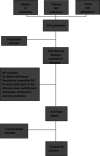Determining risk factors for surgical wound dehiscence: a literature review
- PMID: 23692188
- PMCID: PMC7950784
- DOI: 10.1111/iwj.12088
Determining risk factors for surgical wound dehiscence: a literature review
Abstract
Postoperative wound healing plays a significant role in facilitating a patient's recovery and rehabilitation. Surgical wound dehiscence (SWD) impacts on mortality and morbidity rates and significantly contributes to prolonged hospital stays and associated psychosocial stressors on individuals and their families. A narrative review of SWD was undertaken on English-only studies between 1945 and 2012 using three electronic databases Ovid CINHAL, Ovid Medline and Pubmed. The aim of this review was to identify predisposing factors for SWD and assessment tools to assist in the identification of at-risk patients. Key findings from the included 15 papers out of a search of 1045 revealed the most common risk factors associated with SWD including obesity and wound infection, particularly in the case of abdominal surgery. There is limited reporting of variables associated with SWD across other surgical domains and a lack of risk assessment tools. Furthermore, there was a lack of clarity in the definition of SWD in the literature. This review provides an overview of the available research and provides a basis for more rigorous analysis of factors that contribute to SWD.
Keywords: Surgical site infection; Surgical wound breakdown; Surgical wound dehiscence.
© 2013 The Authors. International Wound Journal © 2013 Medicalhelplines.com Inc and John Wiley & Sons Ltd.
References
-
- Webster C, Neumayer L, Smout R, Horn S, Daley J, Henderson W, Khuri S, Qua NVAS. Prognostic models of abdominal wound dehiscence after laparotomy. J Surg Res 2003;109:130–7. - PubMed
-
- Phan TQ, Theodorou P, Depner C, Lefering R, Perbix W, Spilker G, Weinand C. Failure of secondary wound closure after sternal wound infection following failed initial operative treatment: causes and treatment. Ann Plast Surg 2013;70:216–21. - PubMed
-
- Mclaws ML, Irwig LM, Mock P, Berry G, Gold J. Predictors of surgical wound‐infection in Australia—a National Study. Med J Aust 1988;149(11–12):591–5. - PubMed
Publication types
MeSH terms
LinkOut - more resources
Full Text Sources
Other Literature Sources


